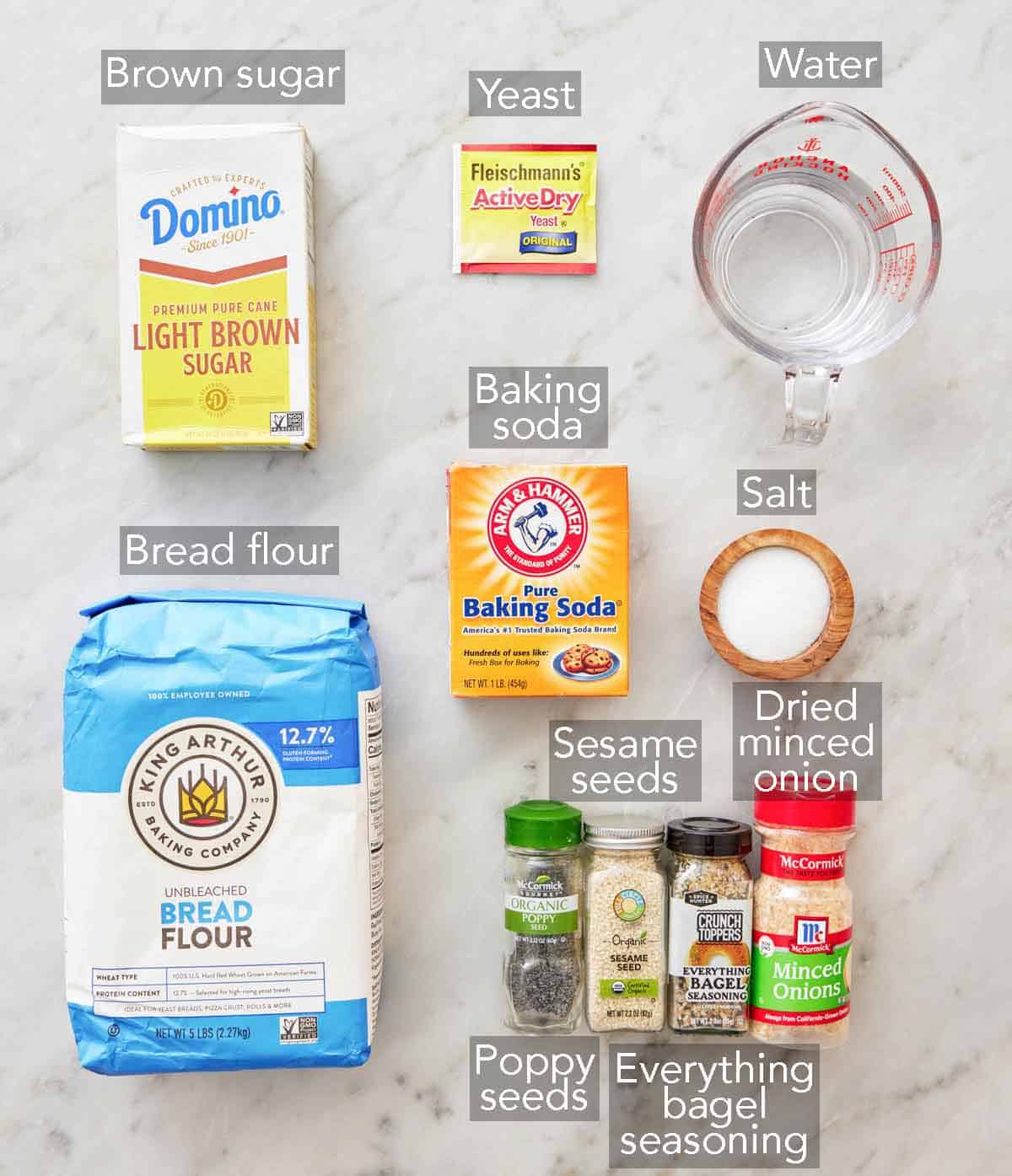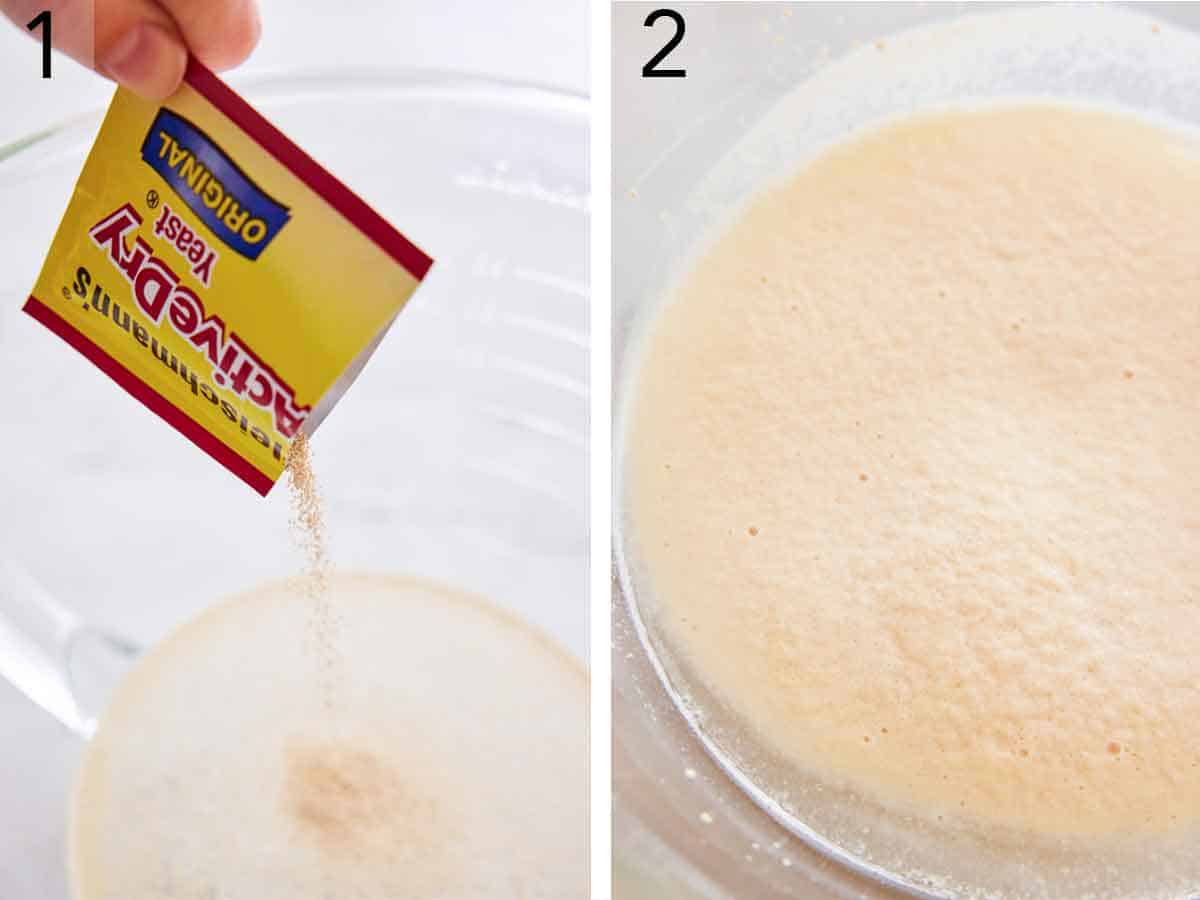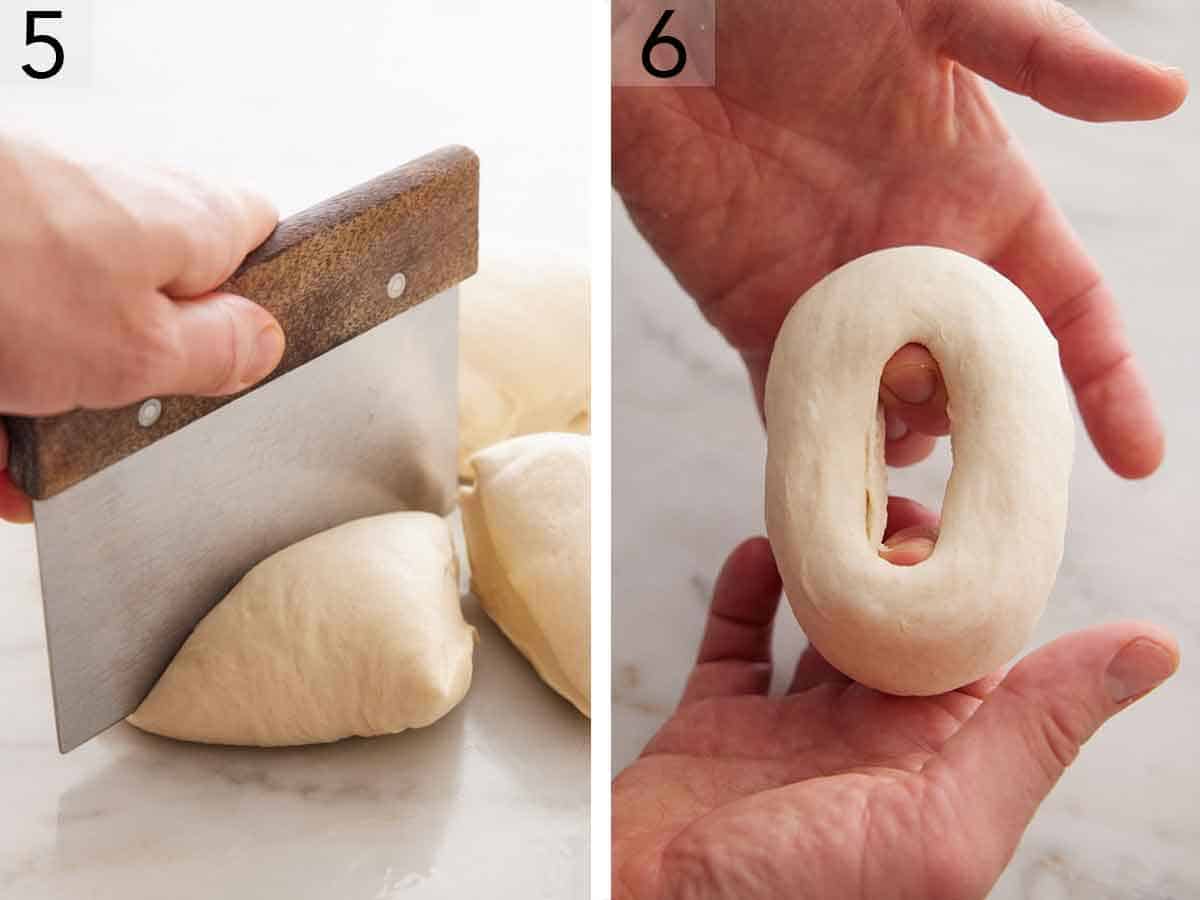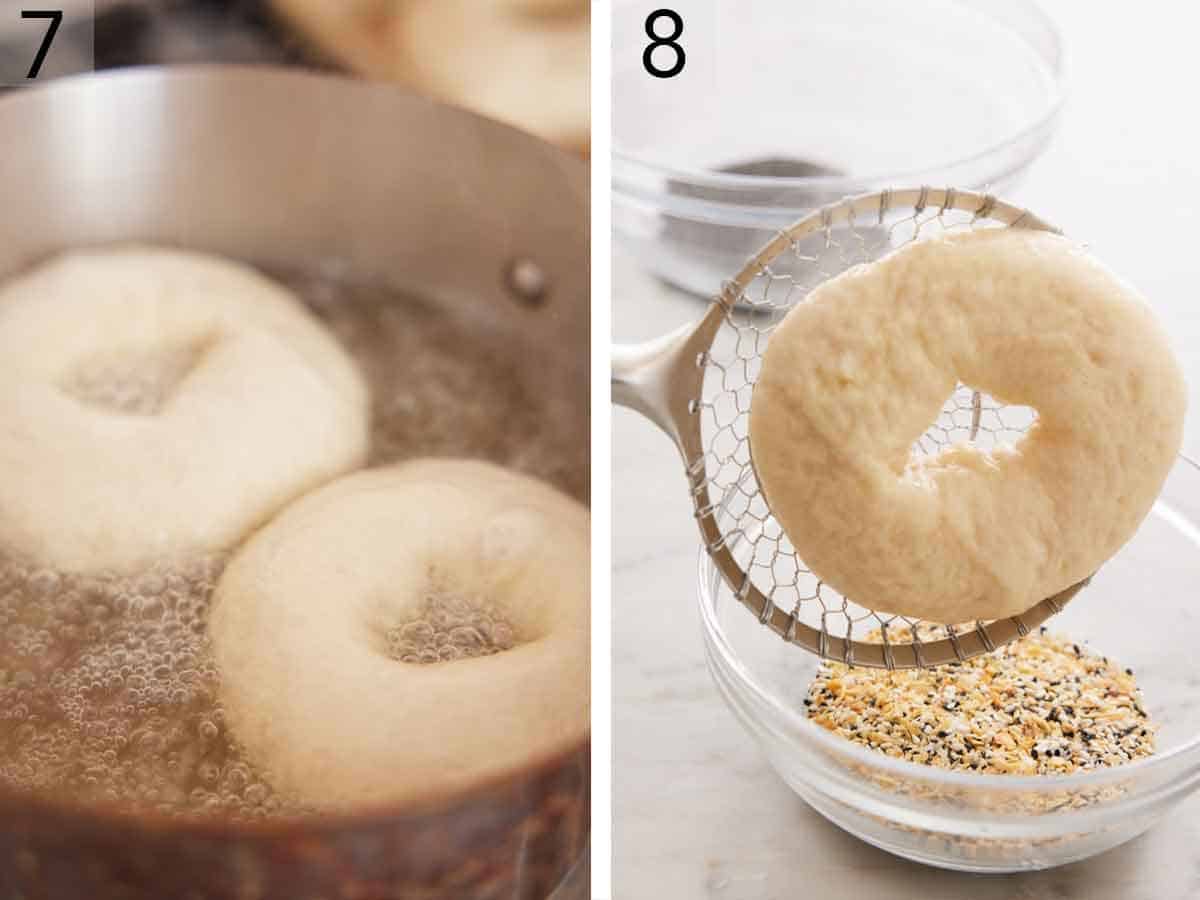You only need a few basic pantry staples to make this bagel recipe right in your kitchen. You don’t even need any fancy kitchen tools, as you can easily mix the dough together by hand! It may seem intimidating to make bagels at home, but I promise you that it’s super easy to make them from scratch. They’re so much more delicious when fresh out of the oven.
This easy bagel recipe has everything you love about bagels! They are slightly sweet with a classic toothsome chew, a shiny and crisp exterior, and a soft but dense interior. Enjoy them as is, with a schmear of cream cheese, or toasted! Either way, these homemade bagels are so delicious. Want another delicious bread recipe to enjoy fresh out of the oven? Try my breadsticks recipe, brioche bread recipe, or sourdough bread recipe.
What You Need to Make This Recipe

Yeast — always double-check the expiry date of your yeast before starting this bagel recipe. If it is past its best-before date, pick up a new packet of yeast, or your bagels will not rise.
Sugar — you can use sugar or barley malt syrup if you have that on hand to help activate the yeast. You’ll also need sugar or barley malt syrup to boil the bagels in, as it adds a bit of sweetness as well as crispiness to the bagels once baked.
Flour — for the best bagels, use bread flour. The high protein in the flour will give you the most wonderful dense and chewy bagels. While in a pinch, you can use all-purpose flour to make homemade bagels. However, the bagels will not be as chewy as bread flour gives you a stronger, more developed gluten structure, so you get that distinctive toothy chew when you bite into the bagel.
Toppings — feel free to use your favorite bagel toppings! Some of the go-to toppings are everything bagel seasoning, sesame seeds, poppy seeds, and dried minced onion.
How to Make This Bagel Recipe

1. In a large mixing bowl or the bowl of a stand mixer fitted with a dough hook, combine the water, sugar or malt syrup, and yeast and stir together.
2. Let stand until the mixture is very foamy.

3. To the yeast mixture, add the flour and salt.
4. Mix together using a wooden spoon or turn the mixer on low speed and mix until a dough starts to form. If mixing by hand, turn out the dough onto a lightly floured surface and knead by hand until a smooth and elastic dough is formed. If using a stand mixer, continue mixing on low speed for about 10 to 15 minutes. Transfer the dough to a large lightly oiled bowl. Cover and let rise in a warm place until doubled in size.

5. Punch down the dough and turn out onto a clean work surface. Divide the dough into 8 equal pieces. (For smaller bagels, divide into 12.)
6. Shape each piece into a ball, then gently flatten each ball. Lightly oil your hands, then press your finger into the center and through the dough, creating a small hole. Pick up the dough and begin stretching it in a circular motion, widening the hole and creating a donut shape. When the hole is about 2 inches wide, place it on a greased parchment paper lined sheet pan, spacing each one a few inches apart. Loosely cover and let rest for 20 minutes.

7. Place the water in a large wide pot and bring it to a boil over medium-high heat. Reduce the heat to medium-low to maintain a simmer and stir in the sugar or syrup and baking soda. Working with two or three at a time, add bagels to the pot of water. Cook for 1 minute. Using a spider or slotted spoon, flip them over and cook for another minute.
8. Remove each bagel, letting the excess water drain off, and place it back on the baking sheet. Immediately sprinkle on or dip in the toppings of your choice, if desired. Bake for 15 minutes. Flip the bagels over and continue baking for 5 to 10 minutes or until deep golden brown. Let cool on a wire rack for at least 10 minutes before serving.

Pro Tips for Making This Recipe
- The time it takes for your bagel dough to rise depends on the temperature of your kitchen, as it’ll take longer to rise if you have a cold kitchen. The ideal temperature for the dough to rise is between 75 to 78F. If your kitchen is on the colder side, you can place your bagel dough in an OFF oven with the light on.
- Avoid adding too much flour to the dough by measuring your flour correctly! Adding too much flour to the bagel dough is a common mistake. The best way to measure flour is by using a scale. If you don’t have one, then fluff your flour with a spoon, sprinkle it into your measuring cup, and use a knife to level it off.
- Make sure the water is between 110 to 120F. If your water is too hot, it will kill the yeast, but if the water is not warm enough, it won’t activate it.
- Barley malt syrup can be found in some grocery stores or ordered online. It gives bagels their signature flavor, but delicious ones can still be made without it! Just use granulated or brown sugar in its place.
- Check the dough for doneness after kneading by doing the window pane test. Pinch a small ball of dough off, then stretch it into a thin square. It should become thin enough to see light through without breaking. If it breaks or tears, keep kneading.
- For the most even coating of topping on your bagels, dip them into a shallow bowl of toppings instead of sprinkling them on top.
- Be gentle when shaping and handling the bagel dough for smooth and shiny bagels. If you squeeze the dough too roughly, the bagels may look wrinkly when they come out of the oven. However, not to worry, they’ll still be just as delicious!

Frequently Asked Questions
Boiling the bagels before baking them will help an outer crust form to ensure they keep their shape as they bake. In addition to helping them keep their shape when you boil the bagels, the sugar or barley malt syrup in the water will help with caramelization and crispiness once you bake the bagels. Boiling the bagels will also help the toppings stick better to the dough.
If you only have instant yeast, that is fine! Whisk the instant yeast into the flour, sugar, and salt mixture, then add the water. You do not need to bloom instant yeast. The first rise time will be shorter, around 20 minutes instead of an hour. Just make sure it has doubled in size before you cut and shape the dough. Once shaped, the second rise might be shorter than 20 minutes.
You can prepare the bagel recipe’s dough the night before and place it in the fridge overnight for its first rise. This way, you can shape and cook them the next day. Doing an overnight rise will also help the flavors in the dough develop more and give you an even better-textured bagel! Remove the dough from the fridge when ready to use and let it rise at room temperature for another 45 minutes before you proceed with the recipe.
You can store leftover bagels in an airtight container for up to 3 days. I recommend slicing them when ready to serve, as you risk them becoming stale when you store them after slicing.
You can! Bagels freeze wonderfully! Slice them, tightly wrap them in plastic, and transfer them to a freezer-safe bag for up to 3 months. If you plan on toasting them, you can toast them straight from frozen! If not, thaw them before using them.
If you’ve tried this Bagel recipe, then don’t forget to rate the recipe and let me know how you got on in the comments below, I love hearing from you!

Bagel Recipe
Video
Equipment
- Large mixing bowl
- Stand mixer with dough hook or wooden spoon
- Baking Sheets
- Parchment paper
- Large wide pot
- Spider strainer or slotted spoon
- Wire cooling rack
Ingredients
For the Dough:
- 1½ cups warm water 100-110F (360ml)
- 1 tablespoon sugar or barley malt syrup
- 2¼ teaspoons active dry yeast (0.25-ounce packet/7g)
- 4½ cups bread flour plus more for sprinkling (540g)
- 2 teaspoons salt
For Boiling and Assembly:
- 3 quarts water (2.8L)
- 3 tablespoons sugar or barley malt syrup
- 1 teaspoon baking soda
- Toppings such as everything bagel seasoning, sesame seeds, poppy seeds, dried minced onion
Instructions
For the Dough:
- In a large mixing bowl or the bowl of a stand mixer fitted with a dough hook, combine the water, sugar or malt syrup, and yeast and stir together. Let stand until the mixture is very foamy, about 10 minutes.
- To the yeast mixture, add the flour and salt. Mix together using a wooden spoon or turn the mixer on low speed and mix until a dough starts to form. If mixing by hand, turn out the dough onto a lightly floured surface and knead by hand until a smooth and elastic dough is formed, about 10 to 15 minutes. If using a stand mixer, continue mixing on low speed for about 10 to 15 minutes. (The dough should start to pull cleanly away from the bowl and “slap” the sides while mixing after about 8 minutes. Add another tablespoon of flour as needed.) Transfer the dough to a large lightly oiled bowl. Cover and let rise in a warm place until doubled in size, about 1 hour.
- Line two large baking sheets with parchment paper and lightly grease the paper.
- Punch down the dough and turn out onto a clean work surface. Divide the dough into 8 equal pieces. (For smaller bagels, divide into 12.) Shape each piece into a ball by cupping your hand around the dough ball and moving it in a circular pattern. (This will tighten the ball.)
- Gently flatten each ball. Lightly oil your hands, then press your finger into the center and through the dough creating a small hole. Pick up the dough and begin stretching it in a circular motion, widening the hole and creating a donut shape. When the hole is about 2 inches wide, place it on the greased parchment paper, spacing each one a few inches apart. Loosely cover and let rest for 20 minutes.
For the Boiling and Assembly:
- Meanwhile, preheat the oven to 425F.
- Place the water in a large wide pot and bring it to a boil over medium-high heat. Reduce the heat to medium-low to maintain a simmer and stir in the sugar or syrup and baking soda.
- Working with two or three at a time, add bagels to the pot of water. (They might sink to the bottom of the pot.) Cook for 1 minute. Using a spider or slotted spoon, flip them over and cook for another minute. (They should be floating at this point if they weren’t already.) Remove each bagel, letting the excess water drain off, and place it back on the baking sheet. Immediately sprinkle on or dip in the toppings of your choice, if desired.
- Bake for 15 minutes. Flip the bagels over and continue baking for 5 to 10 minutes or until deep golden brown. (Flipping creates a more even bake and helps keep their round shape.) Let cool on a wire rack for at least 10 minutes before serving. Cool completely before storing in an airtight container for up to 3 days. Bagels freeze great! Just cut in half before freezing.
Notes
- The time it takes for your bagel dough to rise depends on the temperature of your kitchen, as it’ll take longer to rise if you have a cold kitchen. The ideal temperature for the dough to rise is between 75 to 78F. If your kitchen is on the colder side, you can place your bagel dough in an OFF oven with the light on.
- Avoid adding too much flour to the dough by measuring your flour correctly! Adding too much flour to the bagel dough is a common mistake. The best way to measure flour is by using a scale. If you don’t have one, then fluff your flour with a spoon, sprinkle it into your measuring cup, and use a knife to level it off.
- Make sure the water is between 110 to 120F. If your water is too hot, it will kill the yeast, but if the water is not warm enough, it won’t activate it.
- Barley malt syrup can be found in some grocery stores or ordered online. It gives bagels their signature flavor, but delicious ones can be made without it! Just use granulated or brown sugar in its place.
- Check the dough for doneness after kneading by doing the window pane test. Pinch a small ball of dough off, then stretch it into a thin square. It should become thin enough to see light through without breaking. If it breaks or tears, keep kneading.
- For the most even coating of topping on your bagels, dip them into a shallow bowl of toppings instead of sprinkling them on top.
- Be gentle when shaping and handling the bagel dough for smooth and shiny bagels. If you squeeze the dough too roughly, the bagels may look wrinkly when they come out of the oven. However, not to worry, they’ll still be just as delicious!















Sara McEntire says
I have been making your sourdough bread recipe every week for months now with consistent results and decided to try bagels for the first time. Wow!! Perfectly chewy and crisp, not one bit dense. One day later and already plotting another batch.